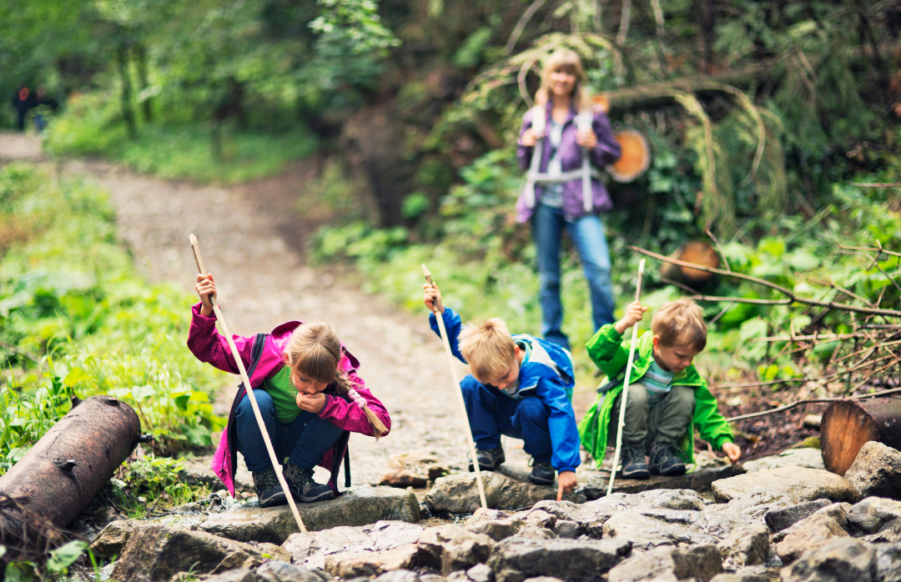Given the many ways being in nature benefits children, connecting kids with nature is crucial. Research increasingly shows how being outside boosts kids’ mental and emotional well-being while enriching their development. Meanwhile, we are increasingly aware of how younger generations are spending less and less time outdoors. In this Outdoor Tips post, let’s review some strategies for helping kids get outdoors and connecting with nature.
Looking for a breakdown of the many benefits that kids get from being outside? Check out this post!
1. Take interest in your surroundings!

One of the most important ways to get kids to spend time in the outdoors is to do so yourself. Gulo in Nature‘s mission is to help you better connect with the outdoors, and by doing so you can help kids do the same. Psychologists call this importance practice “modeling the behavior”.
The idea is simple: by showing interest in nature and learning about the natural world, you demonstrate to kids that spending time outside can be fun and fulfilling. Sometimes doing the behaviors you want to see is the most effective way to communicate them. Children may inherently copy parents’ or mentor’s behavior, and learn from it, more quickly than they understand spoken words.
5 ways to better connect with nature
Check out my TEDx talk below for tips on how to connect with nature in your everyday life!
2. Allow for unstructured time
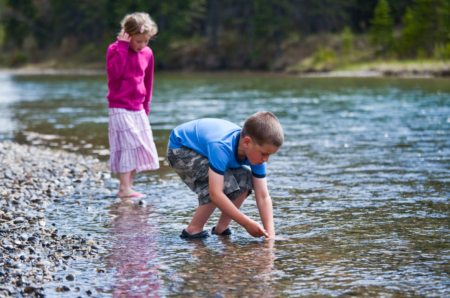
Time outside with children doesn’t have to specifically be about connecting with or learning about the outdoors. In fact, many of the mental health benefits of outdoor time come just from being in natural spaces. Unstructured time, where there are no particular objectives or goals, can be an especially helpful tool for connecting kids with nature.
By letting kids take the lead and decide their own activities, you can allow them the space to interact with natural spaces in a more creative way. This is more likely to lead to the sort of spontaneous learning experiences that create a long-lasting connection. Furthermore, these help cultivate soft fascination, the mental state most strongly associated with the mental health benefits of time nature exposure.
3. Schedule time away from electronics

The instant dopamine rush and addictive nature of many mobile and videogames means that kids and adults alike are bombarded with rapid and powerful stimuli for most of each day. This can rapidly suck up extra time and lead to an unhealthy amount of indoor time. With that comes lack of activity and sedentary behavior, leading to substantial health impacts over the long term.
9 reasons why kids should spend time in nature
Because of this, it’s easy to spend hour after hour on a screen. Furthermore, kids’ hectic schedules can make it difficult to find the time for outdoor exposure. This makes it especially important to deliberately schedule outdoor time. Even if its only once a week, such repeated exposure can build healthy habits and help cultivate an active interest in the outdoors.
20 minutes of outdoor recreation a week have been linked to substantial health benefits, and even 5 minutes a few times a week can make a major difference. So don’t let outdoor time fall by the wayside. Schedule it in and make arrangements!
3. Take walks together
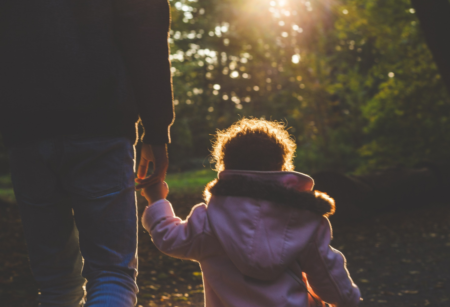
My most impactful nature experiences as a kid were walking in the New England woods with either my mother or father. Even though I often had trouble getting out of bed on Saturdays, I looked forward to walking our dog in the forest. I can still remember the plants and wildlife we encountered during those walks, which made me feel comfortable doing my own outdoor recreation as a teenager and adult.
Walking is generally an accessible and easy activity that doesn’t require specialized equipment. Furthermore, it allows you and the child to observe and interact with nature at your own pace. This can involve things like:
- Listening for birdsong
- Checking out a cool insect, mushroom, or plant
- Admiring views
- Watching nearby wildlife
Nature walks can also help kids develop useful skills like following trails, navigating, and problem solving in the outdoors.
4. Bring some nature home
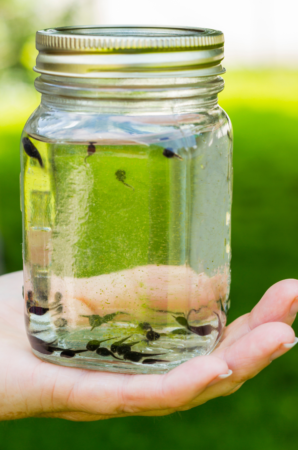
Another way for kids to get a closer look at nature is to find ways to provide nature experiences at home. This can take a number of forms, for example:
- Gardening for wildlife and creating spaces that invite wildlife to your home
- Indoor activities like pressing flowers or sketching wildlife
- (Responsibly!) collecting specimens from the outdoors
- Make an aquarium or terrarium to house (responsibly!) captured animals
IMPORTANT DISCLAIMER: In some countries and states, it is illegal to capture and keep some kinds of wildlife. Capturing or collecting endangered or protected species can be a federal crime, while many other species are protected by law. In the U.S., Mexico, and Canada, for instance, all wild birds are protected and may not be captured or handled without a permit. By contrast, most invertebrates like insects and snails are not off limits. Check your state and national rules before collecting anything, and always seek to minimize impact on your local natural spaces!
One especially engaging way to bring nature home for kids is to raise caterpillars, tadpoles, or wild seeds like acorns. This allows kids to see how these organisms grow and develop over time. If you have a particularly good terrarium or aquarium setup, it can even show students how these organisms live out their life cycle. Some good examples are:
- Raising caterpillars on their desired food plant – to do this, you’ll need to know the caterpillar’s species and the specific plants it needs to eat!
- Planting an acorn – you can even decide to plant the baby tree in your backyard!
- Collecting pondwater to watch invertebrates – lots of aquatic insects are easily visible in a scoop of pondwater. Leaving them in a jar for a few hours, you can watch them swim and navigate the bottom. These should be released back into their original pond after a few hours to ensure that they don’t die.
The great 20th century naturalist Anna Botsford Comstock‘s guide on teaching children about nature is a fantastic source for these sorts of ideas. You can grab a copy here!
5. Learn to identify plants & wildlife

Children love learning the names of animals and plants from an early age. Because of this, moving from “what sound does a cow make?” to “what kind of bird is that?” can be a pretty straightforward move! Of course, learning some of your local wildlife on your own can be a prerequisite. But as with point number 1 above, you can always go about this learning with a child!
Being able to tell identify important or interesting species can be an empowering way to connect kids with nature. When it comes to plants like poison ivy or stinging nettles, it’s also important for safety. Kids’ minds are often a sponge for this sort of information, so they will learn quickly!
Check out these outdoor smartphone apps to help you learn more about the outdoors
6. Provide nature-themed reading materials

There are loads of excellent nature-themed kids books available, and these make a fantastic resource. Even field guides for adults can be fun for kids to look at pictures and see the variety of life they can encounter outdoors. Books can help kids get excited about the outdoors and get an idea of the kinds of wildlife they may find. Furthermore, it provides an alternative to screentime and practice for reading comprehension.
Your local library is always a great first option for finding high-quality nature books. Keep an eye out for future Gulo in Nature posts on nature books going forward!
7. Visit a natural history or science museum

Spending quality time in nature can be difficult some times of year. Beyond that, many people don’t have ready access to outdoor spaces. This is especially true in urban areas, where connecting kids with nature can be especially challenging. In such cases, science and natural history museums can be a great resource.
Natural history museums typically have amazing displays for all ages that offer an accessible look at the wonders of the natural world. Although this is no replacement for being outside, it can be a great way to help kids learn more about nature before their next outdoor experiences. By learning about how nature works, or even seeing certain species clearly displayed in dioramas and pictures, they can recognize more of what they see.
Many cities and college campuses have natural history or science museums which offer content for children. It’s worth keeping an eye out for one in your neighborhood, or on your next trip!
8. Have a scavenger hunt
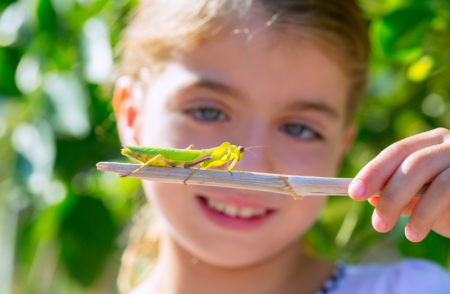
For kids more interested in focused tasks, scavenger hunts can be a great way to get children some meaningful time outdoors. Before heading outside, you can make a list of things to look for. This will force kids to slow down and mindfully examine their surroundings—a key part of connecting with nature!
To avoid having a negative impact on the local habitat, it’s best to have tasks be about spotting things, rather than collecting them. Devices like smartphones and nature-related apps can make this easier by allowing kids to snap photos of their discoveries.
Here are some things you might put on a scavenger hunt:
- A leaf with a hole in it
- A mushroom on a log
- Tracks or other wildlife signs
- Something green that isn’t a plant
- An insect with no wings
- A bird’s feather
- Two different kinds of moss
- A curved stick
- A snail shell
- A berry, bud, or flower
Thanks for reading about ways of connecting kids to nature!
Have you found helpful strategies for getting kids out into nature? Let us know in the comments! If you enjoyed this post, please support the blog by sharing this post with friends and following us on Social Media. If you’ve got a burning nature question or a post you’d like to see on Gulo in Nature, we’d love to hear from you! You can get in touch using the Contact Page.

